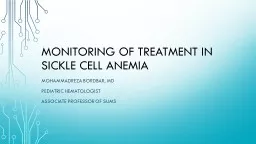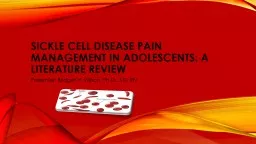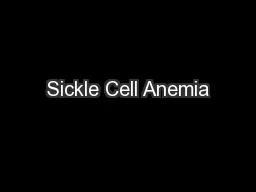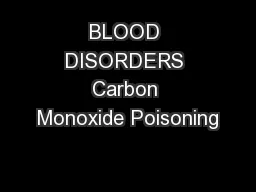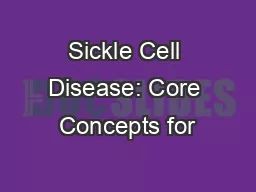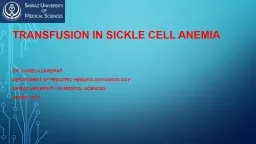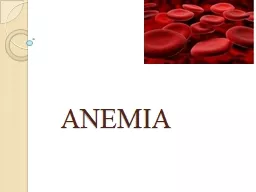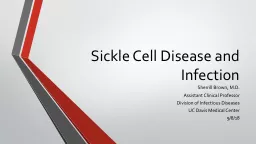PPT-Monitoring of treatment in sickle cell anemia
Author : calandra-battersby | Published Date : 2020-04-03
Mohammadreza Bordbar MD Pediatric Hematologist Associate professor of SUMS Qeshm island 22 feb 2018 Introduction Care for persons with SCD often lacks continuity
Presentation Embed Code
Download Presentation
Download Presentation The PPT/PDF document " Monitoring of treatment in sickle cell ..." is the property of its rightful owner. Permission is granted to download and print the materials on this website for personal, non-commercial use only, and to display it on your personal computer provided you do not modify the materials and that you retain all copyright notices contained in the materials. By downloading content from our website, you accept the terms of this agreement.
Monitoring of treatment in sickle cell anemia: Transcript
Mohammadreza Bordbar MD Pediatric Hematologist Associate professor of SUMS Qeshm island 22 feb 2018 Introduction Care for persons with SCD often lacks continuity Two SCDspecific diseasemodifying treatments HU blood transfusion still underutilized. EXAMINING PREVALENCE OF TOBACCO,. ALCOHOL, ILLICIT DRUG USE IN. ADULTS WITH SICKLE CELL ANEMIA. Catherine A. Seamon, Darlene T. Allen, . James G. Taylor VI, Jonathan Wilson, Gregory J. Kato . Disclosures. &. Intercollegiate Athletics. Sickle Cell Trait. (Hereditary Condition) . Red blood cells (RBC’s) are normally round, circular or disc shaped.. RBC’s have hemoglobin component (helps carry oxygen) and platelets (helps in clotting). Presenter: Bridget H. Wilson, Ph.D., MS, RN. Introduction. Sickle cell disease (SCD) pain continues to emerge among adolescents. Over 98,000 individuals are believed to have SCD within the United States. . Katie Coltharp and Mariela Saenz. Names of Disorder. HbS. disease. Hemoglobin S disease. Hemoglobin SS disease. Sickling. disorder due to hemoglobin S. Sickle cell disease (broad term). Sickle cell disorders (broad group of conditions). CO binds to your . hemoglobin. , prevents oxygen from binding. Can be fatal. It is a "silent killer" as people often die in their sleep when a heater fails.. Carbon monoxide deaths are more likely to occur in winter. Sickle Cell Trait. (Hereditary Condition) . Red blood cells (RBC’s) are normally round, circular or disc shaped.. RBC’s have hemoglobin component (helps carry oxygen) and platelets (helps in clotting). the Emergency Physician and Nurse. Epidemiology, Genetics, Pathophysiology. . Paula Tanabe. , PhD, RN, FAEN, FAAN. Associate Professor. Duke University, Schools of Nursing and Medicine. Objectives. Dr. Soheila . zareifar. Department of pediatric hematology/oncology. Shiraz university of medical sciences. Qeshm. 2018. Transfusion in Sickle Cell. In sickle cell disease transfusions improve blood flow by reducing the proportion of red cells capable of forming sickle hemoglobin polymer. . (SCAFO). By Pastor Marcia Taylor, Founder, CEO. 2021. Our programs are specifically designed and dedicated to accommodating the needs of those who are faced with the challenges of Sickle Cell such as access to care, socio-economical support services, mental health, substance abuse, family and/or care provider educational support, and isolation. . Dr. M. . Sofi. MD; FRCP (London); . FRCPEdin. ; . FRCSEdin. The term . sickle cell disease . (SCD) is generally used to describe all of the conditions associated with the phenomenon of . sickling. , whereas the term . a sign . of an underlying . disorder. There are several kinds of anemia. . A. . physiologic . approach classifies anemia according to whether. the deficiency in erythrocytes is caused by a defect in . globin. chains. Abnormalities in these proteins are referred to as . hemoglobinopathies. Two hemoglobin gene clusters are involved in the production of hemoglobin and are located at the end of the short arm of chromosomes 16 and 11, respectively. . Infection. Sherrill Brown, M.D.. Assistant Clinical Professor . Division of Infectious Diseases. UC Davis Medical Center. 9/8/18. Disclosures. None. Goals for Discussion. Discuss the mechanisms that make Sickle Cell patients more susceptible to infections.. Dr. Sonalika’s Eye Clinic provide the best Conjunctivitis (Pink Eye) treatment in Pune, Hadapsar, Amanora, Magarpatta, Mundhwa, Kharadi Rd, Viman Nagar, Wagholi, and Wadgaon Sheri
Download Document
Here is the link to download the presentation.
" Monitoring of treatment in sickle cell anemia"The content belongs to its owner. You may download and print it for personal use, without modification, and keep all copyright notices. By downloading, you agree to these terms.
Related Documents

